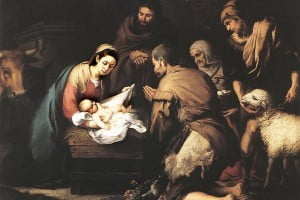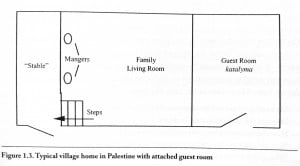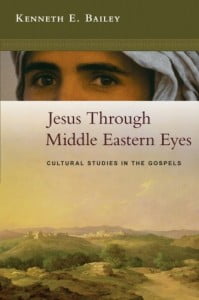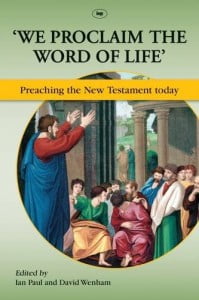Jesus wasn’t born in a stable
http://www.psephizo.com/biblical-studies/jesus-wasnt-born-in-a-stable/
 I
am sorry to spoil your preparations for Christmas before the Christmas
lights have even gone up—though perhaps it is better to do this now than
the week before Christmas, when everything has been carefully prepared.
But Jesus wasn’t born in a stable, and, curiously, the New Testament
hardly even hints that this might have been the case.
I
am sorry to spoil your preparations for Christmas before the Christmas
lights have even gone up—though perhaps it is better to do this now than
the week before Christmas, when everything has been carefully prepared.
But Jesus wasn’t born in a stable, and, curiously, the New Testament
hardly even hints that this might have been the case.So where has the idea come from? I would track the source to three things: issues of grammar and meaning; ignorance of first-century Palestinian culture; and traditional elaboration.
The elaboration has come about from reading the story through a ‘messianic’ understanding of Is 1.3:
The ox knows its master, the donkey its owner’s manger, but Israel does not know, my people do not understand.The mention of a ‘manger’ in Luke’s nativity story, suggesting animals, led mediaeval
The second issue, and perhaps the heart of the matter, is the meaning of the Greek word kataluma in Luke 2.7. Older versions translate this as ‘inn’:
And she brought forth her firstborn son, and wrapped him in swaddling clothes, and laid him in a manger; because there was no room for them in the inn. (AV).There is some reason for doing this; the word is used in the Greek Old Testament (the Septuagint, LXX) to translate a term for a public place of hospitality (eg in Ex 4.24 and 1 Samuel 9.22). And the etymology of the word is quite general. It comes from kataluo meaning to unloose or untie, that is, to unsaddle one’s horses and untie one’s pack. But some fairly decisive evidence in the opposite direction comes from its use elsewhere. It is the term for the private ‘upper’ room where Jesus and the disciples eat the ‘last supper’ (Mark 14.14 and Luke 22.11; Matthew does not mention the room). This is clearly a reception room in a private home. And when Luke does mention an ‘inn’, in the parable of the man who fell among thieves (Luke 10.34), he uses the more general term pandocheion, meaning a place in which all (travellers) are received, a caravanserai.
The difference is made clear in this pair of definitions:
Kataluma (Gr.) – “the spare or upper room in a private house or in a village [...] where travelers received hospitality and where no payment was expected” (ISBE 2004). A private lodging which is distinct from that in a public inn, i.e. caravanserai, or khan.The third issue relates to our understanding of (you guessed it) the historical and social context of the story. In the first place, it would be unthinkable that Joseph, returning to his place of ancestral origins, would not have been received by family members, even if they were not close relatives. Kenneth Bailey, who is renowned for his studies of first-century Palestinian culture, comments:
Pandocheion, pandokeion, pandokian (Gr.) – (i) In 5th C. BC Greece an inn used for the shelter of strangers (pandokian=’all receiving’). The pandokeion had a common refectory and dormitory, with no separate rooms allotted to individual travelers (Firebaugh 1928).
Even if he has never been there before he can appear suddenly at the home of a distant cousin, recite hisgenealogy , and he is among friends. Joseph had only to say, “I am Joseph, son of Jacob, son of Matthan, son of Eleazar, the son of Eliud,” and the immediate response must have been, “You are welcome. What can we do for you?” If Joseph did have some member of the extended family resident in the village, he was honor-bound to seek them out. Furthermore, if he did not have family or friends in the village, as a member of the famous house of David, for the “sake of David,” he would still be welcomed into almost any village home.
 Moreover,
the actual design of Palestinian homes (even to the present day) makes
sense of the whole story. As Bailey explores in his Jesus Through Middle-Eastern Eyes,
most families would live in a single-room house, with a lower
compartment for animals to be brought in at night, and either a room at
the back for visitors, or space on the roof. The family living area
would usually have hollows in the ground, filled with straw, in the
living area, where the animals would feed.
Moreover,
the actual design of Palestinian homes (even to the present day) makes
sense of the whole story. As Bailey explores in his Jesus Through Middle-Eastern Eyes,
most families would live in a single-room house, with a lower
compartment for animals to be brought in at night, and either a room at
the back for visitors, or space on the roof. The family living area
would usually have hollows in the ground, filled with straw, in the
living area, where the animals would feed.This kind of one-room living with animals in the house at night is evident in a couple of places in the gospels. In Matt 5.15, Jesus comments:
Neither do people light a lamp and put it under a bowl. Instead they put it on its stand, and it gives light to everyone in the house.This makes no sense unless everyone lives in the one room! And in Luke’s account of Jesus healing a woman on the sabbath (Luke 13.10–17), Jesus comments:
Doesn’t each of you on the Sabbath untie your ox or donkey from the manger [same word as Luke 2.7] and lead it out to give it water?Interestingly, none of Jesus’ critics respond, ‘No I don’t touch animals on the Sabbath’ because they all would have had to lead their animals from the house. In fact, one late manuscript variant reads ‘lead it out from the house and give it water.’
 What, then, does it mean for the kataluma
to have ‘no space’? It means that many, like Joseph and Mary, have
travelled to Bethlehem, and the family guest room is already full,
probably with other relatives who arrived earlier. So Joseph and Mary
must stay with the family itself, in the main room of the house, and
there Mary gives birth. The most natural place to lay the baby is in the
straw-filled depressions at the lower end of the house where the
animals are fed. The idea that they were in a stable, away from others,
alone and outcast, is grammatically and culturally implausible. In fact,
it is hard to be alone at all in such contexts. Bailey amusingly cites
an early researcher:
What, then, does it mean for the kataluma
to have ‘no space’? It means that many, like Joseph and Mary, have
travelled to Bethlehem, and the family guest room is already full,
probably with other relatives who arrived earlier. So Joseph and Mary
must stay with the family itself, in the main room of the house, and
there Mary gives birth. The most natural place to lay the baby is in the
straw-filled depressions at the lower end of the house where the
animals are fed. The idea that they were in a stable, away from others,
alone and outcast, is grammatically and culturally implausible. In fact,
it is hard to be alone at all in such contexts. Bailey amusingly cites
an early researcher:Anyone who has lodged with Palestinian peasants knows that notwithstanding their hospitality the lack of privacy is unspeakably painful. One cannot have a room to oneself, and one is never alone by day or by night. I myself often fled into the open country simply in order to be able to thinkIn the Christmas story, Jesus is not sad and lonely, some distance away in the stable, needing our sympathy. He is in the midst of the family, and all the visiting relations, right in the thick of it and demanding our attention. This should fundamentally change our approach to enacting and preaching on the nativity.
But one last question remains. This understanding of the story has been around, even in Western scholarship, for a long, long time. Bailey cites William Thomson, a Presbyterian missionary to Lebanon, Syria and Palestine, who wrote in 1857:
It is my impression that the birth actually took place in an ordinary house of some common peasant, and that the baby was laid in one of the mangers, such as are still found in the dwellings of farmers in this region.And Bailey notes that Alfred Plummer, in his influential ICC commentary, originally published in the late nineteenth century, agreed with this. So why has the wrong, traditional interpretation persisted for so long?

I think there are two main causes. In the first place, we find it very difficult to read the story in its own cultural terms, and constantly impose our own assumptions about life. Where do you keep animals? Well, if you live in the West, away from the family of course! So that is where Jesus must have been. Secondly, it is easy to underestimate how powerful a hold tradition has on our reading of Scripture. Dick France explores this issue alongside other aspects of preaching on the infancy narratives in in his excellent chapter in We Proclaim the Word of Life. He relates his own experience of the effect of this:
[T]o advocate this understanding is to pull the rug from under not only many familiar carols (‘a lowly cattle shed’; ‘a draughty stable with an open door’) but also a favourite theme of Christmas preachers: the ostracism of the Son of God from human society, Jesus the refugee. This is subversive stuff. When I first started advocating Bailey’s interpretation, it was picked up by a Sunday newspaper and then reported in various radio programmes as a typical example of theological wrecking, on a par with that then notorious debunking of the actuality of the resurrection by the Bishop of Durham!So is it worth challenging people’s assumptions? Yes, it is, if you think that what people need to hear is the actual story of Scripture, rather than the tradition of a children’s play. France continues:
The problem with the stable is that it distances Jesus from the rest of us. It puts even his birth in a unique setting, in some ways as remote from life as if he had been born in Caesar’s Palace. that’s the message of the incarnation is that Jesus is one of us. He came to be what we are, and it fits well with that theology that his birth in fact took place in a normal, crowded, warm, welcoming Palestinian home, just like many another Jewish boy of his time.And who knows? People might even start asking questions about how we read the Bible and understand it for ourselves!
PS I would love to hear from anyone who has had the courage to re-write the children’s Christmas story to fit with this reading—and managed to pull it off without getting lynched!
Comments
Post a Comment